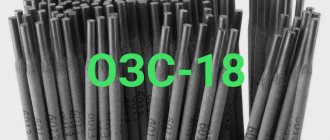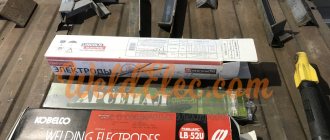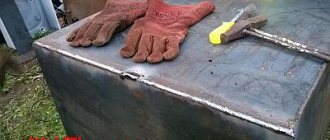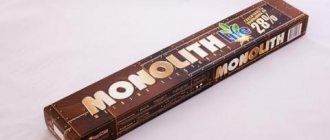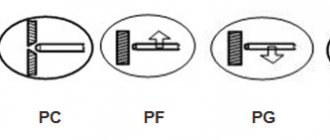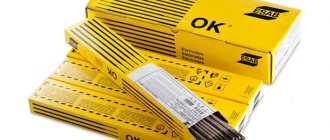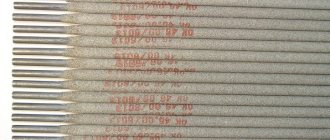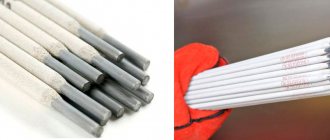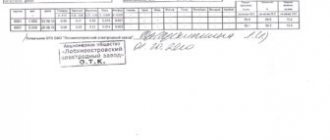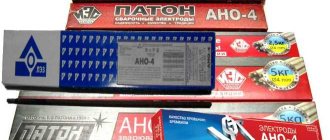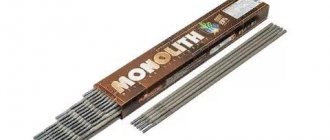Electrodes brand UONI-13/45 – features
The main purpose of the material is welding parts made of low- or medium-carbon steel during the installation of particularly critical structures. Thanks to these electrodes, a seam with increased ductility and impact strength is obtained. The created structures can be used for decades at low temperatures. A typical example is pipelines laid in the northern latitudes of Russia.
High ductility and impact strength of the weld metal are ensured due to the main coating of the rod:
- the coating contains calcium fluoride (CaF2);
- During the welding process, hydrogen, which is harmful to the metal, binds with fluorine into a volatile compound and evaporates from the metal surface.
Thus, the amount of hydrogen in the metal is reduced to a minimum. Thanks to this, hot cracks are eliminated, and the risk of cold cracks (due to hydrogen diffusion) is also practically reduced to zero. Thanks to these same properties, the seam does not crack in a hydrogen sulfide environment. This allows the pipes to be used not only in northern climatic zones, but also in areas where there are deposits with a high content of hydrogen sulfide (oil and gas).
UONI-13/45 (NAKS, RRR, RS) 5 mm (6 kg) Current - constant, reverse polarity
172.68 rub. ? with VAT per 1 kg.
UONI-13/45 (NAKS, RRR, RS) 5 mm (1 kg) Current - constant reverse polarity
RUB 190.68 ? with VAT per 1 kg.
UONI-13/45 (NAKS, RRR, RS) 4 mm (6 kg) Current - constant reverse polarity
172.68 rub. ? with VAT per 1 kg.
UONI-13/45 (NAKS, RRR, RS) 4 mm (1 kg) Current - constant, reverse polarity
RUB 190.68 ? with VAT per 1 kg.
Description and scope of application
The consumable type is a steel rod with a protective coating. Under the influence of high temperature, the coating burns out and turns into a gas, separating the molten metal from the oxygen of the atmospheric air.
Most electrodes of this type are used for the manufacture of:
- lightly loaded structures;
- thin-walled pipes and low-pressure tanks.
It is allowed to carry out surfacing repairs with their help.
The scope of application depends on the brand of E42 electrodes. They are available in different designs, differing in diameter and composition of the protective coating.
Improved SSSI E42A
The only variety with basic coating.
It contains phosphorus compounds and carbides, prevents the appearance of hot cracks and gives the weld the following properties:
- plastic;
- impact strength.
These features are indicated by the index “A” in the marking.
They allow the use of E42A type electrodes for the manufacture of structures:
- placing high demands on reliability, including those experiencing alternating loads;
- operated at low temperatures.
UONI E42A electrodes contain phosphorus compounds and carbides.
Consumables are produced in the UONI 13/45 category and have the following distinctive features:
- They work only with direct current of reverse polarity (electrode-positive).
- They require cleaning the joined workpieces from rust, oil stains, dirt and water.
- Not suitable for welding in high humidity conditions.
- They are used economically due to the presence of iron powder in the coating, which compensates for the loss of metal due to evaporation and splashes.
UONI E42A electrodes are intended for the manufacture of critical structures in the workshop.
They are capricious, so the welder requires experience and dexterity. Inverter-type welding machines are used; rectifiers are not capable of ensuring stable arc burning. The current should not be increased, as this has a bad effect on the quality of the seam.
Types of coating and diameters
In addition to the main coating, the following is used:
- Sour. It contains oxides of iron, silicon and manganese. Such electrodes are used to weld with caution due to the high probability of so-called formation in the seam. hot microcracks (intergranular fractures).
- Rutile. Rutile is a mineral with large amounts of titanium dioxide. The consumables coated with it form a plastic seam, the level of deoxidation corresponding to semi-quiet steel. They tolerate high current well and do not allow the appearance of hot microcracks.
Acidic electrodes contain oxides of iron, silicon and manganese.
Acid and rutile electrodes of the E42 type are produced under many brands, for example OMA-2, VSTs-4 and 4M, Ogonyok, OZS-23, ANO-6, 6M, 17, etc. They cook well not only permanently, but also AC powered and suitable for beginners.
The diameter of E42 consumables is 2-12 mm. It is selected in accordance with the thickness of the smaller workpiece. This parameter determines the current strength. Thus, to weld corner No. 5 according to GOST 8509-93 with a flange thickness of 6 mm, an electrode of size 4 (mm) is required. The amperage is 120-200 A.
Thick consumables are used to connect massive parts in one pass. In this they are superior to semi-automatic installations on non-consumable electrodes with filler wire supply.
Explanation of markings
The letter “E” means “electrode for manual arc welding”, the number 42 is the temporary tensile strength, which is 42 kgf/sq. mm.
We recommend reading Features and main advantages of using E46 electrodes
The full electrode marking also contains other data, for example E42A-UONI-13/45 SM-4.0-UD GOST 9467-60.
Explanation of product markings:
- SM-4.0 – made of welding wire with a diameter of 4 mm.
- U - intended for welding carbon steel.
- D – has a thick coating. Other options: S – medium, M – thin.
The product meets the requirements of GOST 9467-60.
Decoding the names of electrodes.
UONI-13/45 – characteristics
The standard in accordance with which UONI-13/45 electrodes are produced is GOST 9467–75. The material of the rods is steel grades SV08A and SV08.
- The electrodes have a basic (calcium fluoride) coating.
- Temporary tensile strength – 460 MPa.
- Yield strength – 350 MPa.
- Deposition rate – 9.5 g/Ah.
- Surfacing productivity – 1.3 kg/h (for d 3 mm).
- Electrode consumption per 1 kg of deposited metal is 1.6 kg.
- The type of current used in welding is constant, reverse polarity.
- The spatial position of welding is any except for vertical downhill.
- Products are manufactured with a diameter of 2, 2.5, 3, 4, 5 mm.
Typical chemical composition of the deposited metal: C - 0.09%, Mn - 0.57%, Si - 0.25%, S - 0.014%, P - 0.017%.
Features of SSSI calcination
It is important to heat the oven to 250-280 degrees, and also to ensure uniform calcination of the electrodes. This is achieved using special containers. It is forbidden to keep the electrodes in the oven for more than 4 hours, or to calcinate them more than three times. After calcination, the electrodes should be used within 8 hours
After this time, the event should be repeated.
If everything is done correctly and clearly, without violating technology, the quality of the seams will be at the highest level. The welder will receive a stable arc without the electrode sticking to the surface of the parts being welded.
Main advantages of UONI-13/45
- Easy initial and re-ignition.
- Stable burning of the electric arc.
- High penetration depth, which allows you to weld thick-walled parts.
- Small amount of spattered metal.
- Easy separation of slag crust.
- Extremely low hydrogen content in the weld metal.
- High resistance of the metal to the appearance of crystallization cracks.
- Relatively low consumption of rods.
UONI-13/45 (NAKS, RRR, RS) 3 mm (4.5 kg) Current - constant reverse polarity
RUB 176.64 ? with VAT per 1 kg.
UONI-13/45 (NAKS, RRR, RS) 3 mm (1 kg) Current - constant reverse polarity
RUR 194.64 ? with VAT per 1 kg.
UONI-13/45 (NAKS, RRR, RS) 2.5 mm (4.5 kg) Current - constant reverse polarity
RUB 209.64 ? with VAT per 1 kg.
UONI-13/45 (NAKS, RRR, RS) 2.5 mm (1 kg) Current - constant reverse polarity
RUR 227.64 ? with VAT per 1 kg.
Brands and usage
All UONI electrodes are used for manual arc welding, but are divided into several brands, differing in marking and purpose:
- UONI 13/45 electrodes are used for welding forgings and cast parts, as they provide good toughness and ductility of the weld. The coating contains nickel and molybdenum.
- 13/55 contain phosphorus, silicon, carbon, sulfur and manganese and are mainly used for assembling rolled products and parts made of low-alloy and high-carbon steels. The weld they form is characterized by high strength and resistance to cracking. A distinctive feature is that they do not work upside down.
- 13/65 are the most universal grade, allowing a wide range of work on welding steel structures, ensuring a fairly high quality of the seam. They work in all spatial positions.
- 13/85 are used for work involving parts made of high-strength alloy steel. They work perfectly in all positions and provide an extremely strong connection, which is why they are used when installing critical structures.
Features of use
Before welding, the electrodes must be calcined for an hour at a temperature of 350°C. Other features include:
- Welding is performed outdoors or in well-ventilated areas. This is due to the release of volatile fluoride compounds that are harmful to health.
- The surfaces of the parts to be welded must be cleaned of scale, dirt, traces of rust, and moisture must be removed.
- It is not recommended to lengthen the arc - this disrupts the stability of its combustion and can cause the formation of pores in the metal.
Using alternating current for welding is possible, but is also not recommended due to the risks of unstable arc burning.
Using Electrodes
A special feature of these electrodes is the possibility of their use in different positions. The exception is the top-down direction. This means that these rods can be used even during complex installations, when it is difficult to get to the welding site.
Due to the fact that fluorine compounds are released during welding (removing moisture and hydrogen from steel surfaces), working conditions must provide for good air ventilation. This is especially important if work is carried out indoors. The welder must have protective equipment and constant access to fresh air.
Long arc welding is not recommended as it may be unstable. In turn, this can lead to uneven seams. Craftsmen who have used these electrodes advise working carefully with the weld pool. It must be kept liquid for as long as possible, and the connection must be made with a wide seam.
Before work, the electrodes need to be calcined at about 280 - 300°C for an hour. This is necessary so that the moisture content in them decreases to 0.3%. This will be especially important if the enterprise, and therefore the warehouse with consumables, is located in a climate zone with prevailing low temperatures.
Please note that you should calcinate the number of electrodes that you need for work. The fact is that when dried again, the rods lose their properties and provide worse seam quality.
Surfaces should also be prepared before welding. The edges must be cleaned of rust, dirt, lubricants, etc.
Areas of use
In addition to pipelines used in the oil, gas, and chemical industries, electrodes of this brand are widely used for the production of:
- building structures;
- transport equipment (including for the transportation of dangerous goods);
- lifting equipment;
- equipment for metallurgy enterprises.
They are also used to manufacture boilers and boiler equipment, as well as equipment for the oil industry.
Electrodes UONI-13/45 are presented in the MEZ catalogue. These are the own products of the Magnitogorsk Electrode Plant. The high quality of products is confirmed by several documents, including a certificate from the National Welding Control Agency and a certificate of approval from the Russian River Register. The manufacturer indicates on the packaging all the necessary basic welding parameters. Delivery of goods is carried out to all regions of Russia.
Features of application
Each of the melting elements has its own niche of application; USI electrodes are used with the following parameters:
- The welding process occurs using reverse polarity current; the process is required by GOST.
- The seam eliminates the presence of gases and excess impurities by using a special coating of fluoride formations and various carbonates.
- The metal of the rod is used from low carbon steel compounds, which contributes to the reliability of the weld.
- Thanks to organic compounds, welding electrodes UONI 13/55 have low susceptibility to moisture.
- The design, made of low-alloy materials, avoids cracks and irregularities during the welding process.
Welding using UONI electrodes
The seam is not subject to aging or loss of fastening properties when exposed to temperature. Welding with UUNI electrodes should exclude the use of poorly cleaned materials, as they may be subject to corrosion in the future. The process occurs with a short arc, which avoids loss of connection quality. The main advantage over competitors is the result with the required hydrogen concentration, a connection resistant to the appearance of microcracks.
The chemical composition of materials and technology of use may vary depending on the manufacturer. Before purchasing, you need to inquire about compliance with the requirements and standards according to GOST, or the availability of a certificate of certification of welding materials.
Application of electrode welding in construction
Storage conditions
Obtaining a high-quality result depends on the duration and storage conditions of the materials. Storage takes place in rooms with relative humidity up to 50%, without interacting with direct sunlight, air temperature of at least 12 degrees. Subject to all rules, standards and storage conditions of GOST 9466-75, the shelf life of materials can be unlimited.
Download GOST 9466-75
Calcination before use
The electrode coating has a porous structure. In a damp room, it absorbs moisture and the consumable becomes unusable. Its coating crumbles and burns worse; the molten metal does not receive the necessary protection from oxidation.
For this reason, before cooking, the electrodes are subjected to the so-called. calcination.
This is heating in a special oven with controlled temperature and duration. Consumables are placed in forms that ensure a comprehensive and uniform supply of heat.
The manufacturer indicates the procedure parameters on the packaging and in the product description on the official website.
For SSSI electrodes they are:
- temperature: +250…+300˚С;
- time: 4 hours;
- multiplicity: no more than 3 times.
The heated electrodes are placed in a special sealed case with heat-insulated walls. You can make it yourself from a medium-diameter plastic pipe.
UONI coating does not contain organic components, so the temperature during calcination can be increased to 400˚C.
Outside the pencil case, the electrode remains dry for 8 hours. If it is not used up during this time, the procedure should be repeated, but no more than 3 times. Otherwise, the coating will crack and fall off.
SSSI marking and explanation of the main parameters
To distinguish electrodes of even the same brand from each other, they came up with additional markings that determine their purpose. For example, what could the marking e50a or simply e55 mean? Having a special table at hand, you can easily determine what is what and how these names differ.
So, the letter “e” means that this is an electrode designed for manual arc welding. The number 50 is the limit of strength of the connection obtained when used correctly. The letter "A" is used to represent a seam. She says that the seam will be plastic and can easily withstand high impact loads.
This is followed by the name of the SSNI electrodes themselves, after which additional markings are placed, for example, 13-55 or 13-85. After this, the diameter of the steel core is indicated. It is worth noting that it is indicated with an accuracy of tenths of a millimeter. That is, if it’s a 5, then it’s 5.0, if it’s a 4, it’s 4.0, and so on.
At the very end there is a letter “U”, which indicates that this type of electrode is used for welding carbon steels.
Varieties
UONI brand electrodes come in four types:
- 13/45
- 13/55
- 13/65
- 13/85
UONI 13 45 electrodes can be used for welding steel parts. You can cook any steel with any composition. Also, such electrodes are suitable for working with casting. The resulting seams are particularly durable and ductile. Unlike other types of SSSI, 13/45 contains molybdenum and nickel.
Welding electrodes UONI 13 55 are a good choice if you are welding low-alloy, high-carbon steel. You can cook in any spatial position. The exception is top-down welding with standard settings (reverse polarity + direct current). The coating is basic, so the arc burns not very stable (compared to rutile coating). But despite this, the seam turns out to be of quite high quality and is particularly resistant to cracking.
Most likely, you will not weld with UONI 13/65 electrodes if you are a beginner. And all because they are designed to work with particularly critical structures. Can be cooked in all spatial positions. At the same time, the quality of the seam is still better than that of other types of UONI electrodes.
Welding with UONI 13/85 electrodes is justified only when working with heavy-duty alloy steel. In other cases, these electrodes will not be any different from the others. Welding is possible in any spatial position.
